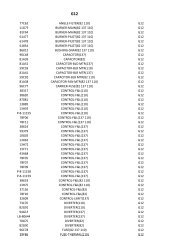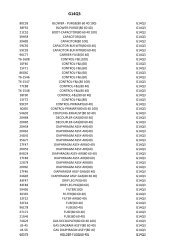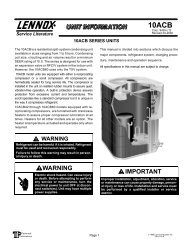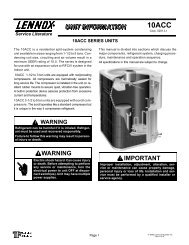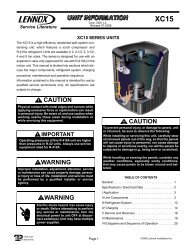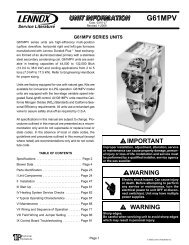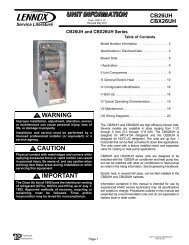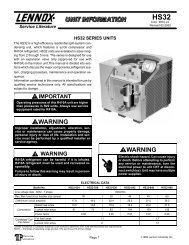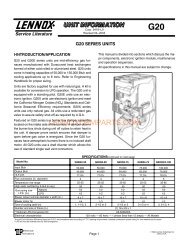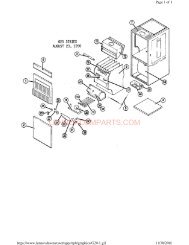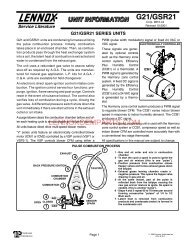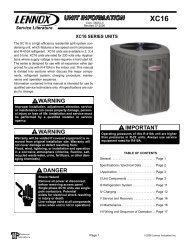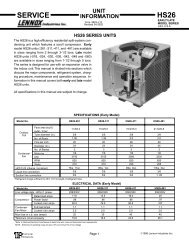g43 service manual - Heating and Air Parts
g43 service manual - Heating and Air Parts
g43 service manual - Heating and Air Parts
Create successful ePaper yourself
Turn your PDF publications into a flip-book with our unique Google optimized e-Paper software.
Follow the next three steps when installing the unit in Non-Direct Vent applications where combustion air is takenfrom indoors <strong>and</strong> flue gases are discharged outdoors.1 − Use field−provided materials <strong>and</strong> the factory−providedair intake screen to route the intake piping as shown infigure 22. Maintain a minimum clearance of 3" (76mm)around the air intake opening. The air intake opening(with the protective screen) should always be directedeither downward or straight out. Use 2" pipe <strong>and</strong> fittingsonly <strong>and</strong> make sure that the air intake does notextend more than 6" beyond the G43UF cabinet.The air intake connector must not be located nearthe floor.2 − Use a sheet metal screw to secure the intake pipe to theconnector, if desired. A pilot indentation is provided in theslip connector to assist in locating <strong>and</strong> starting the fastener.3 − Glue the provided 2" plug into the unused air intake connectoron the opposite side of the cabinet.Testing for Proper Venting <strong>and</strong> Sufficient Combustion <strong>Air</strong>(Non−Direct Vent Applications Only)WARNINGCARBON MONOXIDE POISONING HAZARD!Failure to follow the steps outlined below for eachappliance connected to the venting system beingplaced into operation could result in carbon monoxidepoisoning or death.The following steps shall be followed for each applianceconnected to the venting system beingplaced into operation, while all other appliances connectedto the venting system are not in operation.After the G43UF gas furnace has been started, the followingtest should be conducted to ensure proper venting <strong>and</strong>sufficient combustion air has been provided to the G43UF,as well as to other gas-fired appliances which are separatelyvented. The test should be conducted while all appliances(both in operation <strong>and</strong> those not in operation) areconnected to the venting system being tested. If the ventingsystem has been installed improperly, or if provisionshave not been made for sufficient amounts of combustionair, corrections must be made as outlined in the previoussection.1 − Seal any unused openings in the venting system.2 − Visually inspect the venting system for proper size <strong>and</strong>horizontal pitch. Determine there is no blockage or restriction,leakage, corrosion, or other deficiencieswhich could cause an unsafe condition.3 − To the extent that it is practical, close all building doors<strong>and</strong> windows <strong>and</strong> all doors between the space in whichthe appliances connected to the venting system are located<strong>and</strong> other spaces of the building.4 − Close fireplace dampers.5 − Turn on clothes dryers <strong>and</strong> any appliances not connectedto the venting system. Turn on any exhaustfans, such as range hoods <strong>and</strong> bathroom exhausts, sothey will operate at maximum speed. Do not operate asummer exhaust fan.6 − Follow the lighting instruction to place the appliancebeing inspected into operation. Adjust thermostat soappliance will operate continuously.7 − Test for spillage of flue gases at the draft hood reliefopening after 5 minutes of main burner operation. Usethe flame of match or c<strong>and</strong>le, or smoke from a cigarette,cigar.8 − If improper venting is observed during any of theabove tests, the venting system must be corrected orsufficient combustion/make-up air must be provided.The venting system should be re-sized to approachthe minimum size as determined by using the appropriatetables in appendix G in the current st<strong>and</strong>ardsof the National Fuel Gas Code ANSI−Z223.1/NPFA 54in the U.S.A., <strong>and</strong> the appropriate Natural Gas <strong>and</strong>Propane appliances venting sizing tables in the currentst<strong>and</strong>ard of the CSA−B149 Natural Gas <strong>and</strong> PropaneInstallation Codes in Canada.9 − After determining that each appliance remainingconnected to the common venting system properlyvents when tested as indicated in step 3, returndoors, windows, exhaust fans, fireplace dampers<strong>and</strong> any other gas-burning appliance to their previouscondition of use.Page 25



